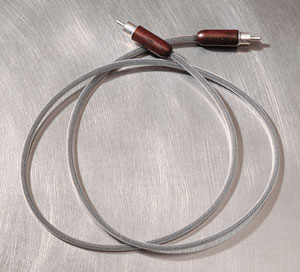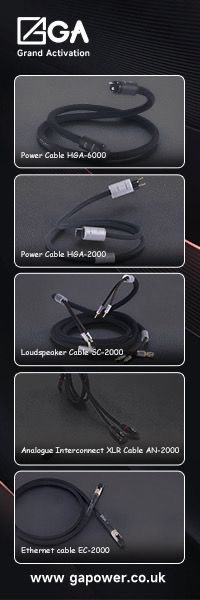Kimber Kable Select KS 2020
| Kimber Kable Select KS 2020 |
|
The Cutting Edge of Digital Cables |
|
Brett Rudolph |
|
23 February 2003 |
 Specifications
Specifications
Silver S/PDIF Digital Cable
Silver RCA type connectors
0.75 meter – $650
Address:
Kimber Kable
2752 South 1900 East
Ogden, Utah 84401
Telephone: 801-621-5530
Fax: 801-627-6980
Website:www.kimberkable.com
From the Start …
The role of digital equipment in stereo and home theater systems has definitely changed since its beginnings years ago. I can remember when almost every article stated that the digital signal wasn’t cable dependant and that even less expensive and lower quality cables were perfectly fine in any system. Since that time, professionals and non-professionals alike have generally concluded that this isn’t true. All digital cables are not created equal and the differences can significantly affect the sound of the digital playback system itself.
One of people responsible for this change is Ray Kimber. For many years, he and his company, Kimber Kable, have shown just what a difference correctly designed and implemented digital cables can make, regardless of the system. Their latest digital product, the Kimber Select KS-2020, serves as an excellent example of how this philosophical change was not only important, but also crucial to continued improvements in the high fidelity audio industry.
The first thing I noticed about the Kimber Select KS-2020, even before hooking it up in my system, was its amazing flexibility. That might seem trivial, but many companies, for different reasons, including proper shielding, manufacture cables that are extremely stiff and difficult to work with in confined spaces. Ultimately, even the perfect cable doesn’t work if it can’t be used. Luckily, the KS-2020 is different.
The KS-2020 features another interesting attribute that deserves mention. Unbalanced digital cables are mainly 75-Ohm cables that have been either modified or adapted to increase performance in passing digital signals without degradation. The KS-2020 is not one of these cables; it was designed from the inside out with the sole purpose of passing square wave modulations used for digital signals rather than the sine wave associated with video and other signals. Kimber claims that the KS-2020 won’t even pass a video signal, though I did not verified this information.
Visually the KS-2020 is what you might expect from an interconnect that costs $650. Its silver colored shield, together with the wooden RCA connectors, make for an extremely impressive presentation. While the wood has no real effect on the cable’s performance, the silver RCA connectors were selected instead of the traditional gold plated or copper clad RCA plugs for functional reasons. Silver does suffer from oxidation as readily; therefore its performance does not degrade as rapidly. Silver is also the material used throughout the cable itself to carry the signal, so there is no transition from one metal to another anywhere in the cable.
All these differences aside, it takes more than just connecting the cable to the digital front end and D/A converter to achieve its best performance. Like all interconnects, the KS-2020 requires time to break-in in order to maximize its performance and function to its fullest. So, after the simple, straightforward connection, I was “forced” to wait through the 150-hour break-in period before I could do any real critical listening or evaluation. This waiting period is one of the few similarities this digital cable had to others I have used in the past.
Changes Come
The morning arrived when I could finally get started and see just how much of a difference this cable would make in my reference system. Using my Pioneer Elite DV-047A as a transport, the first thing I noticed with the KS-2020 installed was a vast improvement in overall dynamics. All the music I played, without exception, seemed more lifelike and detailed than it had on my system before its insertion.
The first album that I really listened to was Pink Floyd’s Dark Side of the Moon [Capital Records B000002U82]. The album starts with a rhythmic pulse, more of a feeling than a sound, and as it increases in frequency it becomes more and more apparent that the rhythm is actually a heartbeat. Depending on the system, the changeover from just feeling to intelligible sound can take varying lengths of time to occur; better systems usually achieve the change more rapidly. With the KS-2020 in place, I found that recognition came much more quickly than with any other digital cables I had used, indicating a much more dynamic and detailed sound.
On the same album, the track “Us and Them” has always been a favorite of mine, preferably on vinyl – until now. The vinyl pressing seems to contain a level of three dimensionality and detail that the CD version couldn’t duplicate. While the CD wasn’t able to completely replicate the vinyl’s rich sound, taking into account the background noise and analogue artifacts associated with the vinyl playback, this was the first time I had such a difficult time deciding which I preferred.
Another recording that I listened to during the review was Cat Steven’s Tea for the Tillerman. [Mobile Fidelity UDCD 519]. I consider myself lucky to have one of Mobile Fidelity’s famous gold discs of this recording, since they are no longer available from stores. The most important thing about the disc for this review is, that, depending on system quality, its sound ranges from good to superior, far exceeding its aluminum counterpart. While I was expecting somewhat better overall sound, I was not prepared for the wholesale improvement the recording presented. It truly was astounding.
The opening strings on “Where do the Children Play?” came alive, for lack of a better description. The detail and three-dimensionality I had discovered with Dark Side of the Moon coalesced to enhance this song in ways I had only dreamt of previously. The end result was a pristine, untouched version that would rival any recording of this material.
Not all the CD recordings I used in this review were Pop or Rock. One of the most revealing I used was Mephisto & Co., [Reference Recordings RR-82CD]. This well done audiophile quality recording is often the bane of even good digital playback systems. The most subtle jitter problem can affect the overall fidelity, especially when it comes to the ability to discern placement of individual instruments and sounds. It turned out to be one of most lifelike playbacks I have heard from this recording.
There was one downside to the KS-2020 that I should mention before going any further with the review. The KS-2020 is extremelyrevealing. While I won’t claim the soundtrack from Days Of Thunder, [Greffen DIDX 008085] was mixed to be an audiophile quality recording, this cable makes it very apparent that it was not made to be heard in such detail. There was so much distortion and loss of soundstage from the overly digital sounding music, that I switched recordings to make sure something hadn’t happened to the system itself.
Time for Movies
The nice thing about DVD players is that they play CDs as well as DVDs. This requires the digital cable to accurately and effectively transmit the digital data stream to the D/A converter to produce both stereo and multi-channel sound. Unfortunately, even more than CDs, DVDs tend to have clock issues. Even the slightest jitter introduced by an interconnect can be noticeable, and in extreme cases, can cause a total loss of audio playback.
Though The Wall [Columbia Music Video CVD 50198] is not a film many people have an urge to see or experience, it has some wonderfully rich content that does suffer with even small amounts of jitter, added noise and/or loss of information. The Kimber KS-2020 did an admirable job of transferring the information correctly between DVD player and D/A converter. It did not cause loud passage to become overly digital or bright, or soft passage to become unrealistic or unintelligible. This is something that most of the cables I have used have, to one degree or another, have done.
Another film I used to test the capabilities of the KS-2020 was The Fellowship of the Ring – Special Edition [New Line Productions N55498]. This release happens to be one of my favorite movies besides being a great test to see just how well a system performs. Not only does the movie have some very loud and very soft passages, but it also has a well-recorded musical score, which greatly enhances the films plot. All these various components can create problems for a digital cable that is not very revealing or detailed, causing parts of the movie to lose some, if not all, of their meaning.
The KS-2020 once again worked flawlessly. There was no noticeable loss of detail between loud and soft passages. In fact, in the scenes that contained a large component of music, I could actually discern other details, such as the sounds of the characters clothing or surrounding nature noises, without effort. This held true for both the Dolby Digital and DTS versions, which use drastically different encoding and compression ratios to reproduce the sound.
The Conclusion
Reviewing the KS-2020 was a lesson in both the quality of digital reproduction and the differences in digital cables. While I had always known there were differences between cables, I never quite knew the extent to which it was audible. However, after this review, I can honestly say that I know and appreciate the differences a very good digital cable can offer.
That doesn’t mean that this cable is for everyone. Though it is definitely an amazing cable, it does tend to show problems in music and recordings that others don’t, such as it did with the Days of Thunder soundtrack. If that is the type of music you listen to generally, then I would definitely not recommend this particular cable. It is likely far too revealing and much more expensive a cable than you need and, ultimately, won’t give you the satisfaction that others may.
However, if you are looking for one of the ultimate digital cables on today’s market, the KS-2020 is definitely worth trying in your system. It not only allows for one of the best sounding CD playbacks I have heard, but offers outstanding DVD playback as well. That, combined with its flexibility and ease of connection, in even the tightest of spaces, makes it a cable worthy of anyone’s system and definitely one I am going to add to my reference system without a second thought.
![]()
Don’t forget to bookmark us! (CTRL-SHFT-D)
Stereo Times Masthead
Publisher/Founder
Clement Perry
Editor
Dave Thomas
Senior Editors
Frank Alles, Mike Girardi, Russell Lichter, Terry London, Moreno Mitchell, Paul Szabady, Bill Wells, Mike Wright, and Stephen Yan,
Current Contributors
David Abramson, Tim Barrall, Dave Allison, Ron Cook, Lewis Dardick, John Hoffman, Dan Secula, Don Shaulis, Greg Simmons, Eric Teh, Greg Voth, Richard Willie, Ed Van Winkle, Rob Dockery, Richard Doron, and Daveed Turek
Site Management Clement Perry
Ad Designer: Martin Perry





Be the first to comment on: Kimber Kable Select KS 2020